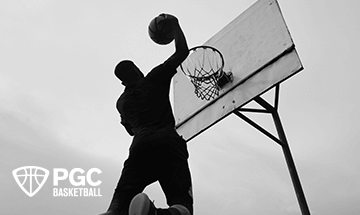How to Coach Winning Shot Selection
PLAYERS OFTEN TAKE SHOTS IN PRACTICE THEY CAN MAKE AGAINST THEIR SECOND LINE, BUT NOT AGAINST THE BETTER PLAYERS THEY FACE IN BIG GAMES.
I invented the term LONHOBIRAT some time ago to indicate what I thought was most important about shot selection. It means, get a Lay-up Or a shot with No Hand up, On Balance, In your Range with Adequate Time to shoot.
The word covers most of what is important in selecting shots but, over a period of time, I found myself changing my own way of teaching shot selection. Yes, those are still the ingredients to be considered, but now I use a numbering system. I begin by simply watching a scrimmage and requiring that my players find a shot that elates me.
When they get a shot that elates me, I call it a 7. If we get a wide open lay-up—a shot we will literally make 99 times out of a hundred, I give that a 9. There is no such thing as a perfect 10. Even an NBA superstar with a wide open dunk can miss. So the best shot possible is a 9.
During a practice, when I call something as not a particularly good shot, a player is likely to argue, “Coach, I can make that shot.”
Indeed, he may very well have just made it. But the problem is, too many shots that athletes choose in practice may score against the second team defense but not against the better players they will face in big games. In other words, the so-so shot that manages to go in during practice too often misses during a game.
As a result, you look back after a big game that you lost by a few points and you have to admit that you chose your way to failure. The other team didn’t beat you. You chose shots that were so so and it’s no big surprise that you missed them.
You cannot let your team choose the very shots in practice that will assure them of losing big games for you. Therefore, other than wanting my players to know that being on balance, being within their range, and having adequate time are all important, I want them—during the action of practice scrimmages—to realize that I’m not interested in arguing about details. I just want to be elated. If the shot was taken a bit off balance, a bit too fast, or a bit too far out, who cares which bit it is? I’m just not elated with that shot, and so taking that shot in practice is not leading us to the promised land.
I give these so-so shots that most teams toss up willingly everyday in practice a 5. They go in fairly often, but they don’t lead to wins in big games, which is precisely what you practice for. (You can win easy games without practice.)
SO HERE’S MY RATING SYSTEM:
9 = A VERY EASY, UNCONTESTED LAY-UP
7 = A GOOD SHOT; I’M ELATED WITH IT
5 = A SO-SO SHOT; IT WORKS OFTEN—IN PRACTICE
3 = A BAD SHOT; A VERY LOW PERCENTAGE SHOT THAT EVERYONE REALIZES SHOULD NOT BE TAKEN—YOU JUST CAN’T HAVE THESE.
When watching practice, I can yell out instantly what a shot is worth. Anytime I’m not sure, I yell the number in between. Am I elated? Then 7. Not sure, but it’s better than a so-so 5? Okay, I give the shot a 6.
When you start thinking about shots in this way, and get your team thinking about them in this way, it becomes a lot easier to get everyone on the same page about shot selection.
Should everyone be allowed to shoot an open shot? Of course not. Everyone should be allowed to shoot a shot that elates me.
The more you practice and the better shooter a player becomes, the more I am likely to be elated by his choices. But every player has the same requirement: elate me.
The reason I have gotten away from talking much about LONHOBIRAT is the L part, the lay-up. I find one of the most common problems teams have is the number of lay-ups they choose and miss, particularly by post players inside.
You work hard teaching guards to look inside and get the ball inside to your big men, and then your big men toss up some whirling loopty-doo shots and—Hello? We’re supposed to all be happy with them?
Sorry. Just because a shot is taken close to the basket does not mean it’s a good shot. In fact, most big men have a habit of turning potential 7s and 9s into 5s and even 3s by tossing up shots that have very little chance of going in.
Often they are going to their weak side, tossing up shots over the hands of defenders who are taller, stronger, and better than the players they face in practice each day. Small wonder that they miss these shots.
Your big men have to be taught to go strong to the basket with their strong hand; otherwise, there is a very good chance they will take a shot that will go in only occasionally when it really matters.
Even more important, big men are very likely to shoot too fast, a problem most young coaches fail to recognize because they think the shot must be taken quickly to avoid nearby defenders.
Yet the best big men in the world take their time and take the shot they want. They don’t hurry. They rely on strength and technique, not speed and surprise.
You must make sure your big people take high percentage shots, just as you have to assure it in your guards who want to stand beyond the three-point arc and toss up prayers. If you don’t demand great shot selection during your practices, you are very unlikely to find yourself elated with your shot selection after your games.
The best way I know to get the shots you want is by making them a requirement in your daily line game scrimmages. When you see a shot that fails to elate you, you don’t need to bother with explanations that irritate your players. Blow that whistle.
Get them to the line, and let some of your players say it. “You weren’t exactly elated with that shot, were you, Coach?”
No, you weren’t elated. The shot went in. It wasn’t terrible, but it wasn’t great. It wasn’t what you wanted your player to select. It was so-so, and you were glad the team recognized it.
You could use a shot like that some day, at the end of a quarter or when a shot clock violation is about to occur. But you don’t want your players choosing that shot in practice; and it makes things a lot easier to have some of them telling you, rather than you constantly having to correct and criticize them.
—Excerpted from the book, “Running the Show”
Related Articles
What Does It Mean To Be Self-Disciplined?
In the game of basketball, self-discipline is a word that all coaches want players to embody on a daily basis. The word ‘Discipline’ is used for some teams as their standard of excellence, for others it is a pillar that their culture is built upon.
A Champion’s Soul
Muhammad Ali famously said “The fight is won or lost far away from the witnesses, behind the lines, in the gym and out there on the road; long before I dance under these lights.”
Grit
Her research found the trait which consistently linked to success in sports, workforce, academia and business was “grit.”
About PGC
PGC Basketball provides intense, no-nonsense basketball training for players and coaches. Our basketball camps are designed to teach players of all positions to play smart basketball, be coaches on the court, and be leaders in practices, games and in everyday life.
We combine our unique PGC culture with a variety of teaching methods and learning environments to maximize the learning potential of those that attend our sessions. In addition to spending 6-7 hours on the court each day, lessons will be reinforced through classroom sessions and video analysis.
Our goal at PGC is to empower you with the tools to fulfill your basketball dreams, while also assisting you in experiencing the joy of the journey.
To learn more about PGC Basketball, including additional basketball training tips and videos, visit our YouTube Channel or find us on Facebook, Instagram, and Twitter.













Share This Post